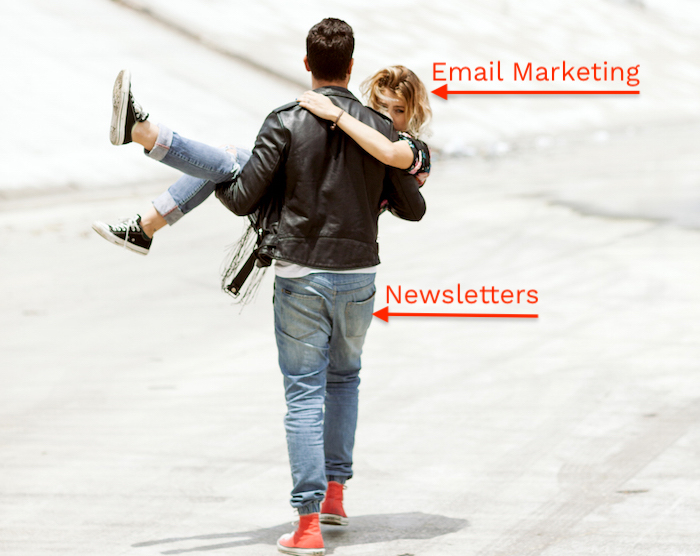by Mark Bloom | Nov 2, 2021 | Small Business Advice

What Is Content Marketing?
Simply put, content marketing is using the power of your website to promote your business and gain new customers. The words you use on your website and in your social media posts comprise your content marketing strategy. This isn’t a passive endeavor; you must conduct proper keyword research to know where to focus your efforts, and you have to refresh your content on a regular basis through:
- Blogging on your website
- Posting to your social media outlets
- Tweaking the content on your website
While search engine optimization (SEO) draws visitors to your website, it’s the content on your site that makes or breaks your attempt to convert those visitors into active customers. That’s the value of content marketing, and that’s why you need to pay attention to content marketing tips. If you’re doing your own content marketing, these tips help you do it more effectively. Even if you’ve hired a firm like Ray Access, these tips help you understand the process.
How Does Content Marketing Work?
Every business has, or should have by now, a professional website. The first content marketing tip is that your chosen keywords have to be used effectively on the website, part of effective SEO. This on-page SEO, comprising the words on the page, is directly under your control.
The content on each page must be attuned to a single concept or subject. For example, if you have a web page about the best mousetrap in the world, a product you sell, that page should describe everything about your mousetrap, mousetraps in general and why yours is the most effective. If your content is understandable enough and persuasive enough, more people will buy mousetraps from you.
What Are Some Content Marketing Tips?
The following content marketing tips come in handy when you’re revising your website copy, planning your blog strategy, trying to attract more visitors to your website or attempting to make your social media posts more engaging. It’s imperative before you embark on a content marketing campaign that you fully understand your market. You should know:
- What they want from you
- What their problems are
- Where they search for answers online
After you know your audience, you can directly write to them. By writing to the specific population that make up your target audience, your content immediately becomes more engaging to them. Other content marketing tips include:
- Publish new content consistently. Every time you change your website and every time you publish a blog post on your website, you force the search engines to re-index your site. By continually adding to your website, you keep your site fresh in the eyes of those search engines, which makes your SEO more effective.
- Write about topics your audience wants to learn about. The second-most important content marketing tip is to write about the things your market wants to know. Write about news involving your industry that’s important or interesting. Provide tips about your products or services. Write about how your company can solve the problems your audience has.
- Write in the language of your audience. This tip isn’t about writing in English; it refers to writing in the tone and vernacular your audience is used to. If your market is small business owners, for instance, don’t write in stilted academic structure. Write so that your content can be easily understood.
- Use keywords appropriately. Keyword research is vital to content marketing, so you capture the same terms that your audience is searching for. Once you have the keywords, you still have to use them correctly. Don’t stuff them into your website; keep the content flowing naturally. This blog post is a prime example, since the keyword phrase, “content marketing tips,” is used properly throughout.
- Proofread before publishing. Never publish anything on your website until you’ve had it reviewed or edited. Nothing ruins your reputation more quickly than misspellings or awkward grammatical mistakes. Keep your content error-free and clear by having it proofread.
- Don’t forget mobile devices. While it’s common knowledge that your website has to be mobile-friendly, content marketing tips wouldn’t be complete if they left out the requirement to make your blog posts and social media posts fit for mobile devices. That translates to short sentences and paragraphs. Make your point concisely.
These content marketing tips are meant to help you increase your SEO and generate more online leads: those visitors who become your customers. If you need help improving your website content or blog posts, contact Ray Access for expert assistance.
Ray Access is a content marketing firm that delivers targeted words to empower your business. Contact us about your specific project to receive a quote or discuss your needs. We write website copy, blog posts, e-newsletters and more. Everything we do is thoroughly researched, professionally edited and guaranteed original.
by Guest Blogger | Oct 18, 2021 | Small Business Advice

Tips for Creating an Effective Company Logo
Ray Access doesn’t usually comment on graphic design choices, website development details or other related topics. But the goal of this blog is to help small businesses and web agencies become more successful. To that end, this article may provide guidance for you to create your logo designs.
Deciding on a color depth (between 16-bit, 24-bit or 32-bit), font family or composition of a company logo may be some of the hardest decisions for a graphic designer or small business owner. It’s no wonder that logo fonts and colors are issues that plague many logo designs. To help you avoid these and other issues when designing your company logos, these five questions (and answers) provide insight into the top mistakes in logo designs.
1. Are You Using an Out-of-Date Logo Maker?
One of the biggest mistakes in logo designs — for professionals, hobbyists and amateurs — is using dated software. Choose a logo maker app that’s frequently updated with new features, tools, templates, and graphics.
Trends and fashions change. Your logo maker app should have features that allow you to keep up. At the very least, you shouldn’t be a decade behind!
2. Do You Have Too Many Colors … and They Don’t Match?
Despite the term, “complementary” colors don’t always match well. These complementary colors are opposite colors on a color wheel that tend to “vibrate” when they’re next to each other. For example, red pairs with green and purple with yellow.
But in a logo, these colors end up making a gaudy-looking design at best. Instead, look for secondary or tertiary colors that match. Also, look for colors that match the mood of your logo.
3. Does Your Composition Make Sense?
Composition is a tough nut to crack. Some non-professional designers just don’t have a sense of what keeps people’s eyes moving in the desired direction. A few rules of thumb include:
- If you have an object getting smaller, it makes an arrow pointing to another place.
- The place you want it to point is also generally inward, although you ideally want them to go in a never-ending circle around your graphics.
Remember, you want to capture their attention from every angle. Don’t push them away from your design or onto others.
4. Have You Created Balance in Your Composition?
Despite the word, imbalance isn’t all about matching the size of one element against another. What determines balance is color, style, size, and other features that give one element more or less attention in comparison to the others.
For example, if you present the logo and name of your place of business, then add “bar and grill,” no one cares if it’s a bar and grill. They’ll probably forget the name of your business completely. In this case, what’s most important? It’s probably not “bar and grill.”
5. Is Your Logo Design Too Complex or Too Simple?
Some business owners place too many elements in a logo, trying to throw everything in at once. “I want peacocks, and trees, and hands, and feet, and every cool color, and the shape of the city I practice in, and a really long name like ‘tranquility’.” Instead, simplify your logo designs.
Other business owners make their logos far too simple, to the point that the design has now become a cubist adventure in surrealism. Abstraction is only good to a certain point. Once you’ve passed critical mass, people have nothing to connect your ideas with. Make your logo as simple as you can while still keeping it relatable.
Avoid These Top Mistakes in Logo Designs!
Now that you know the top mistakes in logo designs, the best thing you can do is to keep learning. Trends and fashions change, but human psychology remains roughly the same. If you’re designing your logos on your own, follow these tips.
If you’re intimidated by the prospect of designing your own logo, Ray Access suggests hiring a local pro who asks the right questions. Logo designs have to match your company mood and values while appealing to your audience.
This was a guest blog post written by guest blogger Ester Adams.
by Mark Bloom | Oct 4, 2021 | Small Business Advice

What Is a Persona?
A persona, as we’ve described before, is a conglomeration of your target audience, a personification of your ideal client or customer. Creating a persona is an exercise in examining and defining your audience so you better understand what they want and need, so you can tailor your message to them.
You can actually create multiple personas for your business or agency if you have several different target markets. For example, Ray Access serves both individual businesses and online agencies with many clients. The number of personas you may need depend on who your customers are.
How Can I Use a Persona?
To really use a persona that you’ve developed, you need to spend time trying to understand what your audience wants and needs. It’s not enough to know that your target market may want to buy your products or services; you have to understand why. Does your work make their lives easier? Does it help them achieve a goal? Does it offer something they don’t have or can’t do on their own? You have to know.
You also need to be able to speak and write in a way that your audience can easily grasp. For example, writing for an aging population is very different than writing for mostly twenty-somethings. Besides the language you employ in your messaging, which helps attract your audience, you must make your message engaging. To use a persona, you must write to that individual.
How Does a Persona Help Me Focus My Message?
You can use a persona to refine the messaging to your customers in a number of ways. The best way to start is to add as much detail to your persona(s) as possible. Give your persona a gender, an occupation, a salary, hobbies, a family size and even a name. Find a stock photo that captures this fictional person.
To craft your message, write directly to that person. The more detail, the better. Don’t write to a 30-something housewife who needs a pocket organizer. Instead, write to Molly, who’s 33, lives in a three-bedroom home with her husband Bobby and her two kids Scott and Jennifer. She struggles to keep up with the kids’ activities while working as a manager of a craft store.
Now you’re writing with a specific person in mind. You can even use Molly’s name in your message, as if you’re speaking to her. (You can always remove her name later.) Do whatever it takes to address Molly’s specific needs and wants, while staying true to your brand.
Can I Test My Message?
If you want to get creative, take your message outside the office. Try something radical, such as:
- The elevator pitch test. In a skyscraper, ride up and down on the elevator until you meet someone who resembles your persona. Strike up a conversation and give the opening of your message. Does it attract their attention for the 15 to 30 seconds you have between floors? If it’s not strong enough to gain at least a raised eyebrow, go back to the drawing board and make the opening lines captivating.
- The lunch stool test. Wait at a popular diner or restaurant until you see someone resembling your persona sit at the counter. Sit down on the next stool and engage politely. Can your message maintain the person’s interest? Craft your message to be sharp, concise and engaging throughout.
- The street interview test. Get out onto the street with a fake microphone. Stop people resembling your persona and ask several questions and then share your message. Does the person stay? For how long? This is a way to gauge the length of your message. Too long and it becomes boring. Too short, and it’s not engaging enough.
Use a persona to fine-tune your messaging so that it’s targeted, concise and compelling from start to finish. Make sure you play the same message to all your personas, or create different messaging for each of the personas you’ve created.
If you’re having trouble creating your message to appeal to your persona, Ray Access can help. Contact us to write messaging that’s targeted to your audience. Count on Ray Access for the most effective content — for your website, blog or newsletter.
Ray Access is a content marketing firm that delivers targeted words to empower your business. Contact us about your specific project to receive a quote or discuss your needs. We write website copy, blog posts, e-newsletters and more. Everything we do is thoroughly researched, professionally edited and guaranteed original.
by Mark Bloom | Sep 20, 2021 | Small Business Advice

Partnerships Can Work for Your Small Business
There is no such thing as a solo entrepreneur. Nobody who’s ever scaled a business from the ground up did it alone. In fact, left to themselves, they wouldn’t have a business. That’s why having a business partner is the best business idea ever. Partnerships can work, and if you click with your partner, you’ll egg each other on to greater heights than either of you could manage alone. A few of the benefits include:
- Backing each other up
- Covering for one another
- Sharing the duties, so you’re not stretched thin
- Reminding each other why you do what you do
The most common reason startups fail is because management or ownership burned out. You can’t do it all on your own, and yet many startup owners feel like they have to. It works until it doesn’t. With a partner, you can get twice as far before you have to start delegating or hiring — whatever taking that next step looks like for your business. There are many other reasons that partnerships work, especially when you begin and then follow a solid, mutual path.
1. Start with Commitment
In a partnership, each person has to have the same level of commitment. If one person feels like he or she is doing more than the other, resentment kicks in, which can spell doom for the business. This happens more often than not, and most partnerships can’t overcome it.
But there are ways around this almost inevitable problem, including:
- Communicate constantly about the workload and the shared responsibilities. It’s up to each of you to encourage the other. It’s about reaching beyond what one of you can accomplish.
- Meet regularly. Outline the duties you each have. Partnerships can work when you talk face-to-face on a regular basis. Email or even Zoom isn’t enough.
- Write down your duties. When you see on paper what each of you is doing or has to do, often resentment dissolves. You don’t have time to keep checking on your partner, but when you know what you’re both doing, you can focus on the work you have to do to keep up.
2. Respect Each Other
You usually know what you’re good at doing. Find out what your partner brings to the table. If your strengths are both the same, you may be in trouble. Partnerships can work better when you both excel at different aspects of the business.
When you learn to respect the abilities of your partner, you believe your partnership can work. That belief can pull you through the inevitable days when things don’t seem so rosy. Other benefits of respecting each other include:
- Trusting that your partner will complete the ongoing duties or the tasks assigned.
- Knowing that problems will be aired early, when there’s time to resolve them.
- Appreciating the work your partner does, but being able to offer constructive feedback that makes you both better.
3. Make Everything Unanimous
Partnerships can work best when you both agree on everything. In the real world, that rarely happens, but when you’re able to communicate with each other, you can both make your arguments without it devolving into an ego fight. You both understand that it’s not about who wins; it’s about helping the business win.
The way you handle disagreements between you and your partner goes a long way in informing you how you’ll both handle adversity. Some tips for resolving internal conflict include:
- Listen, listen, listen to your partner’s argument.
- Think big picture. Which idea truly helps the business more?
- Be willing to let go of your idea if your partner’s starts to make more sense.
- Don’t lose sight of your goals when you’re digging in the weeds.
4. Plan to Succeed; Be Ready to Forgive
When you form the partnership, you obviously want the company to succeed. The division of labor makes life easier. The shared responsibilities mean you both can get more done. The extra resources you both bring to the table can give your business a boost when it needs it most.
But not all plans come to pass. Not every person is perfect. Your partnerships can work when you’re on the same team. If one person makes a mistake, be ready to forgive. Mistakes will happen, and no one makes them on purpose. It may be your turn next. It’s not who’s right and who’s wrong, but who needs support in the moment. Remember:
- When you stick together, you’re twice as strong.
- When one partner makes a mistake with a client or employee, the other person can step in, if needed.
- Like parents, a united front gives the company an authoritative appearance.
5. Make It Legal
A partnership agreement — a legal document that seals your partnership and includes an exit plan — puts in writing everything you expect the partnership to do and to be. It’s your chance to make sure it’s all in writing, duly signed, witnessed and notarized. It’s the basis for your legal formation of the company.
You can still make changes to it later, assuming you both agree, but setting the partnership to paper creates a powerful bond between the two of you. It gives you meaning and may even set out your goals for the business. And it’s a great starting point so partnerships can work.
Ray Access is a partnership. A company founded by El Ray and Mark Bloom, it has flourished over the years. And it’s due to all these factors. Partnerships can work if you put work into your partnerships. Good luck!
Ray Access is a content marketing firm that delivers targeted words to empower your business. Contact us about your specific project to receive a quote or discuss your needs. We write website copy, blog posts, e-newsletters and more. Everything we do is thoroughly researched, professionally edited and guaranteed original.
by Mark Bloom | Aug 23, 2021 | Small Business Advice

Does Creating a Persona for Business Help or Hinder?
To learn more about your audience or target market, you can create polls, hold contests or monitor social media. You can also create a persona, a fabricated character who embodies the most common aspects of your customers. A persona helps you better understand your customers, which in turn helps you better serve their needs.
Admittedly, creating a persona for business takes some time and effort. Is creating a persona worth the effort? The answer depends on how you use it. Once completed, you can leverage your persona — or personas, since you may have multiple customer types — in a number of business-related activities, including:
- Creating targeted content for your website, blog and social media
- Building successful advertising and marketing campaigns
- Redesigning your products and services to better meet your customers’ needs
Whether you’re a solopreneur or a large corporation, developing personas for your business can help you succeed by outmaneuvering your competition and better serving your market. In fact, it can become an ongoing exercise, or at least a task you return to again and again, to check in with your customers to make sure you’re still offering the most appropriate goods and services.
How Do I Start Building a Persona?
The first step toward a persona is confirming basic information about your customer set or sets. For example, Ray Access has two primary customers to serve:
- Individual businesses, including business owners and marketing directors
- Online agencies, such as web developers and SEO firms who need content for their clients
You must identify the customer sets you serve. Are you selling to online retail companies who want to increase their marketing presence? Maybe you serve growing businesses that need a simple solution for payroll. Whatever your market, you need to define it. Then you can begin collecting the information that will confirm your market … or point you in a whole new direction.
What Information Does a Persona for Business Require?
You don’t need complicated or expensive software to start the process of developing a persona for business. A spreadsheet will suffice. But you have to know which information to collect or record for all your customers. And for any information that you don’t know, you must discover. Start with some basic information, such as:
- Geographic location (city and state)
- Gender and age, if relevant
- Income level and education
- Job title with their company
- Outstanding problems they have to solve
- Company goals when buying from your business
- Where they search for answers, including search engines, social media, competitor websites, print material or conferences
- How much each customer spends with your company and how often they return
Make sure to include this information from all your existing customers, but you may be able to get some of this data from prospective customers, such as those who’ve visited your website or signed up for your newsletter. The more information you collect, the more specific (and the more useful) your persona for business becomes. This step requires some effort.
How Do I Build My Persona?
Collecting the information is the most time-intensive part of building a persona. You can get some of this data from your website analytics and past interactions with your customers. To get more information, you may need to come up with a short list of pointed questions, and then send them (by email or better, by phone) to your past customers.
Then comes the fun part: building a persona for business. You can follow several steps to complete your persona, including:
- Gather aggregated data and come up with an average for each category. For example, where are most of your customers located?
- List each point to build a character. For example: write down the average age, income level, job title, gender and home of your average customer.
- Give your persona a name, such as: George or Wendy.
- Find a photo that approximates what your persona may actually look like.
- Put it all together in a large format that you can hang on the wall. The photo and peripheral information give you and your team an image of the exact person you’re trying to reach.
How Do I Use My Persona for Business?
Your team can now imagine your persona when creating content and marketing. How they reach your persona is the key to the whole exercise, but knowing whom you’re trying to attract can streamline your content creation. You’re writing to a specific person, instead of an amorphous “market.”
At Ray Access, the writers and editors believe in finding the market you’re trying to reach. A persona for business helps define the audience. They don’t start writing until they know who they’re writing for. You should do the same.
Ray Access is a content marketing firm that delivers targeted words to empower your business. Contact us about your specific project to receive a quote or discuss your needs. We write website copy, blog posts, e-newsletters and more. Everything we do is thoroughly researched, professionally edited and guaranteed original.
by Mark Bloom | Aug 9, 2021 | Small Business Advice

What Is Email Marketing?
Email marketing’s been in the news a lot lately, but what is it exactly? Consider those direct mail flyers and envelopes that appear in your mailbox every week. Sometimes, they offer coupons. Sometimes, they announce new products, services or locations. These mailers are marketing pieces, and they’re effective. Even if you don’t act on them, you often remember the company names, even if you don’t mean to.
Email marketing works the same way, but with two very important differences:
- Your marketing words are delivered directly to your customers’ email inboxes, instead of their external mailboxes.
- You don’t need to worry about printing costs, although you do often need a web-based service, such as MailChimp or Constant Contact — just two names of many options.
Email marketing, like direct marketing, allows you to send coupons from your business, announce new products, services or locations. You can also use email marketing to share news of your industry. Like blog posts, email marketing pieces can provide tips for better using your products or services. And like all online content, you can use an email marketing specialist to produce effective content.
How Do Newsletters and Email Marketing Work Together?
Newsletters for businesses act as vehicles for email marketing. You can deliver them once a month or as often as twice a month to your email list. Sending a newsletter:
- Keeps your business brand top of mind
- Reminds your customers of your value and quality
- Shares your latest deals and offers
- Delivers useful and valuable information
Newsletters for agencies may have a dual purpose. If you run an internet agency, you can use a newsletter to grow your own business, but you can also offer email marketing services to your clients. It’s another service to help your clients succeed.
Using a professional email marketing specialist takes care of the details for you, including the content creation, the email list management and the delivery process. While you still get the opportunity to approve all content, including the newsletter design, before it gets sent, you don’t have to worry about the details. An email marketing specialist like Ray Access handles it all.
What Do I Need to Start a Newsletter?
The first and most important requirement for a newsletter is a list of email addresses of your clients and prospective clients. Acquiring email addresses is an art and a science. Perhaps the best way, after gathering the email addresses of all your clients, past and present, is to offer something of value on your website that your visitors have to sign up to get, leaving — you guessed it — their email address.
In addition to an email list, you need to either hire an email marketing specialist or buy a membership in an email marketing service that can send out hundreds or thousands of emails at the same time. You need to design a template on that service and then populate it with content however often you plan to send your newsletter.
Interested in starting a newsletter for your business or agency? Contact Ray Access, an email marketing specialist who makes it happen for you. Need more information about email marketing or newsletter? Read some of our other blog posts, including:
Ray Access is a content marketing firm that delivers targeted words to empower your business. Contact us about your specific project to receive a quote or discuss your needs. We write website copy, blog posts, e-newsletters and more. Everything we do is thoroughly researched, professionally edited and guaranteed original.






